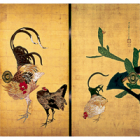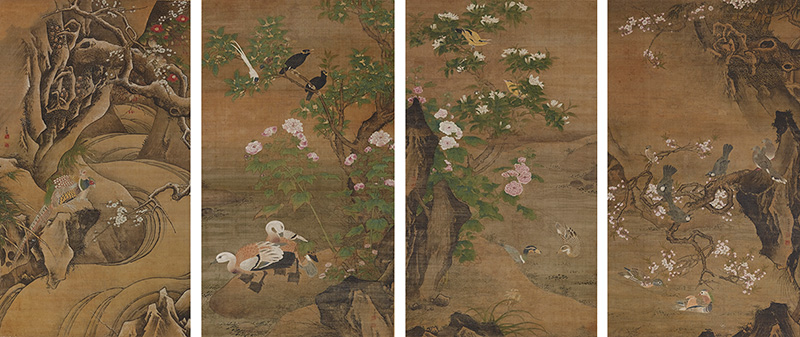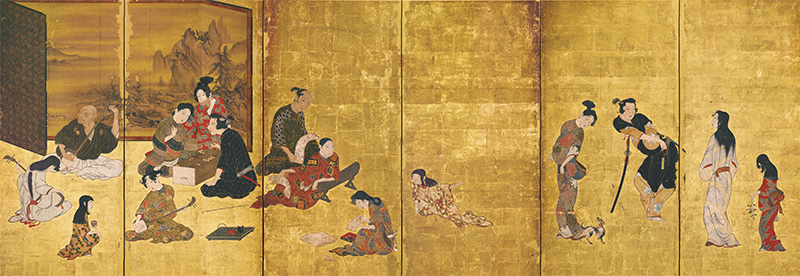Highlights of the Exhibition
Chapter 1: The Lineage of Faith
Chapter 2: The Lineage of Genius
Chapter 3: The Lineage of Classical Literature
Chapter 4: The Lineage of Motifs and Images
Chapter 1: The Lineage of Faith
In Buddhist statues, Buddhist paintings and other art forms shaped by faith, representations of the Buddha obeyed certain conventions derived from sutras or sacred rule books. However, this still left room for the development of special artistic traditions, innovative production techniques, and striking forms. The genre produced many superlative works and these served as models for later masterpieces. This chapter features Buddhist statues carved from single blocks of wood, images of Fugen Bosatsu (Samantabhadra) with hands clasped in prayer, and illustrated biographies of Buddhist patriarchs, painted on large screens. These are all shaped by the prayers and beliefs that prevailed from ancient to the medieval times. They combine conventionality with a sense of innovation befitting of great masterpieces.
Fugen Bosatsu (Samantabhadra) in Prayer
Fugen Bosatsu (Samantabhadra) is a bodhisattva who descends from the Buddhist Eastern Pure Land to save those who chant the Lotus Sutra. He is said to have radiant pearly skin and to ride on a white elephant with six tusks. Ennin was a disciple of the great Buddhist priest Saicho. He was also instrumental in ensuring the prominence of the Tendai school in Japan. After travelling to Tang dynasty China, Ennin returned to Japan carrying new ink line paintings of Fugen Bosatsu. As faith in the Lotus Sutra spread in the mid-10th century, numerous images of Fugen Bosatsu with hands clasped in prayer were depicted in wood carvings, paintings, and illustrated sutras, for example. Fugen Bosatsu is sometimes accompanied by the Ten Rasetsunyo (Raksasi). These are female deities tasked with protecting Buddhist practitioners. In Japan, they are uniquely portrayed wearing the formal robes of Japanese court ladies.
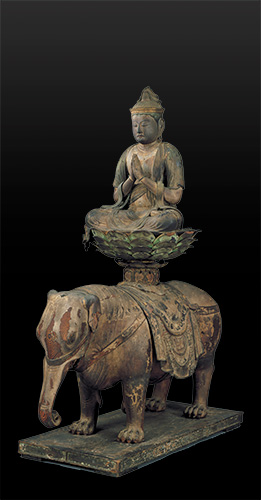
Fugen Bosatsu (Samantabhadra)
Riding an Elephant
Heian period, 12th century
Okura Museum of Art, Tokyo
National Tresure
|
|
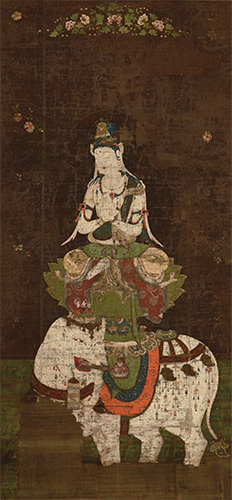
Fugen Bosatsu (Samantabhadra)
Heian period, 12th century
Tokyo National Museum
National Tresure
[On exhibit from April 13 to May 6, 2018]
|
Page Top
Chapter 2: The Lineage of Genius
Masterpieces do not arise unbidden from the minds of geniuses. Instead, they emerge from an interplay between art and people, from an ongoing process of imitation and exploration. Japan’s great masters also studied artworks from overseas and classics from Japan before producing their own unique masterpieces through imitation and innovation. This chapter focuses on three of these masters, Sesshu Toyo, Tawaraya Sotatsu and Ito Jakuchu, and it traces the processes that shaped their representative works.
Sesshu and China
Sesshu assimilated the painting styles of Ming-period China and used them to create dynamic and intricate flower-and-bird paintings. Of particular note is the right-hand part of Flowers and Birds of the Four Seasons. Sesshu has created a richly-complex space filled with various motifs that range off into the distance. This exhibition also features works by Lu Ji and Yin Hong, two Ming flower-and-bird painters. Though painted at a slightly later date, these clearly reveal Sesshu’s sources of inspirations. Sesshu took contemporary “Chinese” painting styles and re-arranged them in the “Japanese” format of a folding screen painting of the four seasons. In doing so, he created a new style of flower-and-bird painting. This style was perfected by Kano Motonobu, a representative artist from the next generation of painters.


Flowers and Birds of the Four Seasons
By Sesshu Toyo, Muromachi period, 15th century, Kyoto National Museum
Important Cultural Property
[On exhibit from April 13 to May 6, 2018]
Flowers and Birds of the Four Seasons
By Lu Ji, China, Ming dynasty, 15th–16th century, Tokyo National Museum
Important Cultural Property
[On exhibit from April 13 to May 6, 2018]
Jakuchu and Imitations
Ito Jakuchu continued to paint roosters and hens throughout his life, a process that culminated in Cactus and Domestic Fowls. The portrayal of a rooster pecking for food traces back to Jakuchu’s early period Plum Tree and Rooster in Snow, for instance, while the humorous expressions, ovoid and triangular bodies, and C-shaped feathers are also familiar motifs from his monochrome ink sketches. The vigorous plumage is also marked by a rough-and-ready ink painting style. This masterpiece is painted on six sliding doors that can be appreciated separately or as one contiguous work. Jakuchu probably familiarized himself with this composition style through the creation of his monochrome ink folding-screen paintings. In this way, we can discern the influence of Jakuchu’s monochrome ink bird pictures on his colored bird paintings
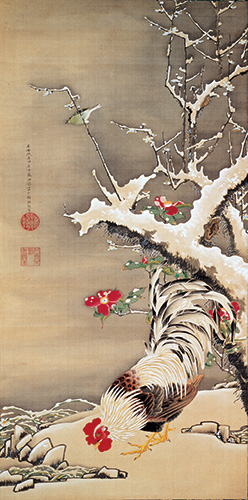 |
Plum Tree and Rooster in Snow
By Ito Jakuchu
Edo period, 18th century
Ryosoku-in, Kyoto |
Cactus and Domestic Fowls
By Ito Jakuchu, Edo period, 18th century, Saifuku-ji, Osaka
Important Cultural Property
Page Top
Chapter 3: The Lineage of Classical Literature
The Tales of Ise and the Tale of Genji are representative examples of classical Japanese literature. Famous scenes from the two works have touched many hearts. They have also provided the inspiration for popular motifs used to decorate craft works such as ceramics, lacquerware and textiles. This chapter examines how these motifs leapt seamlessly from the pages of classical literature to influence a number of masterpieces. These motifs include Yatsuhashi (eight-planked bridge), Mount Utsu, and Tatsutagawa River from the Tales of Ise, for instance, and Yugao (bottle-gourds) and Hatsune (the first warbler) from the Tale of Genji.
The Tales of Ise
The Tales of Ise dates back to the early Heian period. It features prose interspersed with several Japanese waka poems, centered around the poems of Ariwara no Narihira. It is unclear who compiled this ancient text or where its title derives from. Chapter nine of the Tales of Ise is called Azumakudari. Popular since olden times, this chapter includes several episodes that have seeped into the popular consciousness. An art aficionado coming across a painting of a bridge crossing a marsh abloom with irises would recognise this as an allusion to the Yatsuhashi (Eight-planked Bridge) episode, for instance, while a mountain path covered with ivy and maples would bring to mind the Utsunoyama (Mount Utsu) episode. This exhibition reveals how motifs from classic literature have influenced Japanese paintings and decorative art.
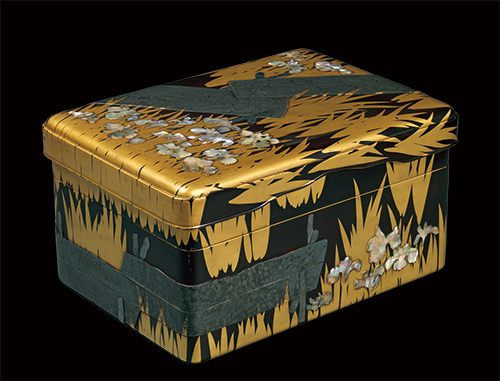 |
Writing Box, Yatsuhashi (eight-planked bridge) design in maki-e lacquer and mother-of-pearl inlay
By Ogata Korin
Edo period, 18th century
Tokyo National Museum
National Tresure
[On exhibit from April 13 to May 6, 2018] |
The Tale of Genji
The Tale of Genji recounts the story of the handsome nobleman Hikaru Genji and the beautiful women he encounters throughout his life. It caused a great sensation in courtly Japan during the Heian period. Just as many acclaimed novels today are adapted into movies, the Tale of Genji was soon recreated in pictorial form. These works are called Genji-e, or ?Genji pictures.” Certain chapters were particularly well-loved. These included Yugao (Bottle Gourds), which recounts Genji’s encounter with a woman who captivated him with her fragile beauty, and Hatsune (First Warbler), which depicts Genji in the prime of his life spending New Year at the Rokujo Mansion. Through pictorial representations of these chapters, we can trace the influence of classical literature on Japanese art.
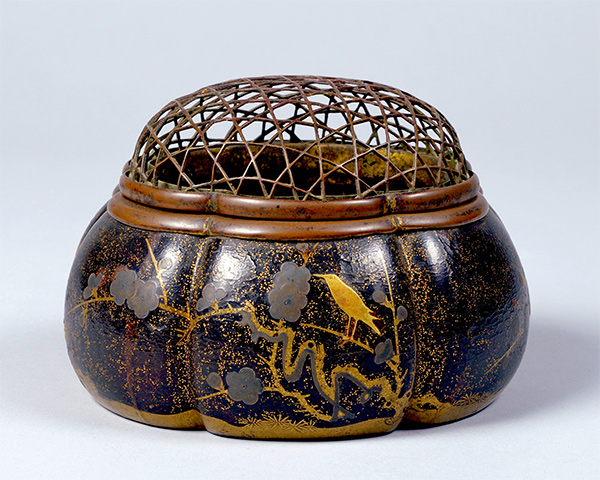
Outer Case of Incense Burner, Hatsune (first warbler) design in maki-e lacquer
Muromachi period, 15th century, Tokei-ji, Kanagawa
Important Cultural Property
|
|
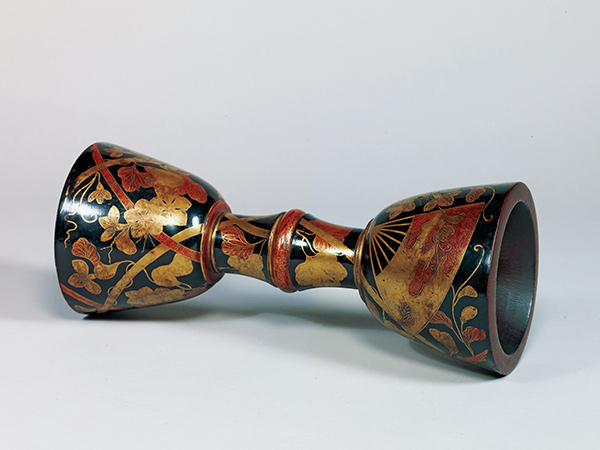
Frame of Okawa Drum, Yugao (bottle gourds) design in maki-e lacquer
Edo period, 17th century
Tokyo National Museum
|
Page Top
Chapter 4: The Lineage of Motifs and Images
Masterpieces themed around the external natural environment and the inner world of human feelings inherit the forms and superlative techniques of earlier masterpieces while adding bold new interpretations and approaches. This final chapter introduces several paintings and decorative art works under three broad themes: “landscapes,” “flowers and birds,” “people,” and “old and new.” It examines the connection between people and art by tracing how various motifs, images and forms were passed down from medieval times to the early modern period, and from the early modern period to the modern era.
The Lineage of Landscapes
Pine trees remain green even throughout the winter months. As such, they featured in Japanese and Chinese artworks as symbols of perennial youth and long life. Japanese-style paintings often depicted pine groves by the seashore. Many colored examples of this genre have survived to the present day. Miho pine Grove was painted by Noami. Noami was in charge of the Ashikaga shogunate’s Chinese painting collection and he studied Chinese monochrome ink paintings. From these, he learnt how to depict air and light using gentle ink-painting techniques. He then used these techniques to paint Japanese scenery. Hasegawa Tohaku was also a keen student of Chinese paintings. He depicted pines up large in his Landscape with Pine Grove and Bridge and he focused solely on pines in the National Treasure Pine Trees. In doing so, he created a uniquely-Japanese ethereal world.


Pine Trees
By Hasegawa Tohaku, Azuchi-Momoyama period, 16th century, Tokyo National Museum
National Tresure
[On exhibit from April 13 to May 6, 2018]
The Lineage of Birds and Flowers
The lotus flower is renowned for its enchanting form and its blooming process. In Asia, it is also imbued with religious significance. For these reasons, the lotus has been represented in art since olden times. In China, there was a boom in lotus painting from the Five Dynasties period onwards, with the Lotus Pond and Waterfowls format then emerging during the Southern Song period. Using various techniques, professional painters depicted the motifs with clear outlines, for instance, while painter-priests emphasized the monochrome ink surfaces, and literati painters dashed out their portrayals in one sitting. The waterfowl motifs also shifted away from ducks to herons, a bird associated with success in China’s civil service examinations. These Chinese lotus paintings were brought to Japan in great numbers, and Japanese artists continued to paint lotuses under a variety of religious and civil contexts.
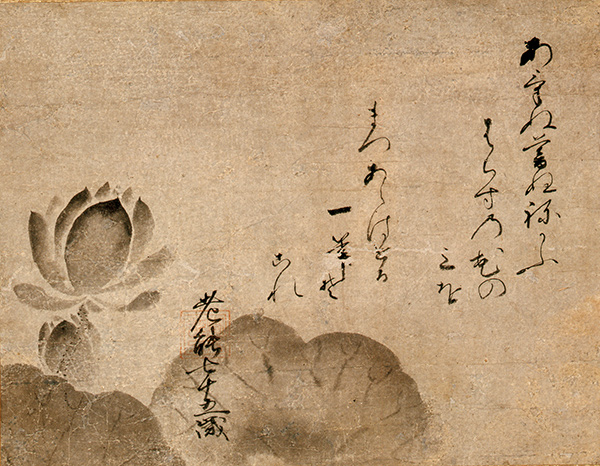
Lotus
By No' ami
Muromachi period, dated 1471
Masaki Art Museum, Osaka
Important Cultural Property
[On exhibit from April 13 to May 6, 2018]
|
|
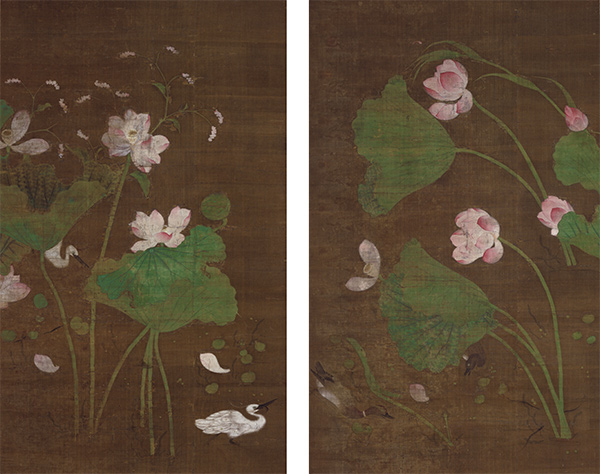
Lotus Pond and Swimming Birds
By Yu Ziming
China, Southern Song dynasty, 13th century
Chion-in, Kyoto
Important Cultural Property
|
The Lineage of Character Studies
Genre Scenes, Known as the "Hikone Screen"
Edo period, 17th century, Hikone Castle Musuem, Shiga, National Tresure
[On exhibit from May 15 to May 27, 2018]
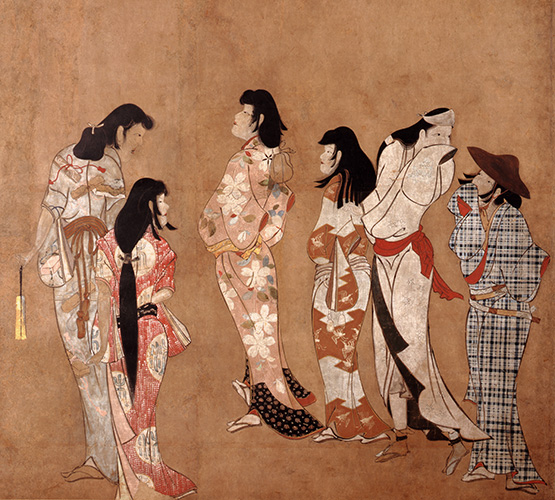
Women in Public Bathhouse
Edo period, 17th century
MOA Museum of Art, Shizuoka
Important Cultural Property
[On exhibit from April 13 to May 13, 2018]
|
|
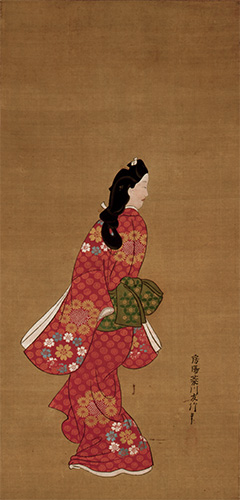
Beauty Looking Back
By Hishikawa Moronobu
Edo period, 17th century
Tokyo National Museum
|
The Lineage between Ancient and Modern
1The artist Kishida Ryusei greatly admired the landscapes produced by Katsushika Hokusai based on European copper-plate engravings. Kishida hung a so-called “Edo-painting Kasumigaseki” at his home, which presumably was one of Utagawa Kuniyoshi’s works. A lover of ukiyo-e from age 20, Kishida was probably aware of the works of Hokusai and Kuniyoshi when he created Road Cut through a Hill. Kishida has borrowed the framing of an ukiyo-e picture to depict a road newly-cut through a hill in Tokyo’s Yoyogi district. In doing so, he has emphasized the vividness of the new landscape in a manner that transcends this framing, while also accentuating the mass and vitality of this natural scene of earth and grass.
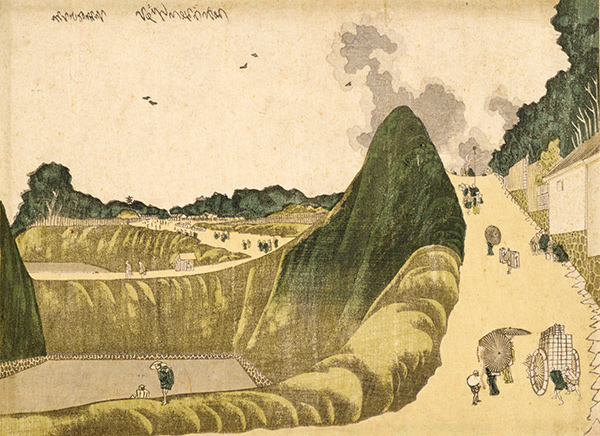 |
Ushigafuchi at Kudan
By Katsushika Hokusai
Edo period, 19th century
Tokyo National Museum
[On exhibit from April 13 to May 13, 2018] |
Page Top
![]() PDF 0.57MB)
PDF 0.57MB)
